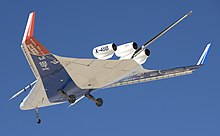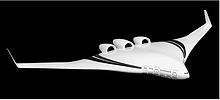Boeing X-48
The X-48 is an experimental aircraft that is being developed by Boeing and NASA to test the properties of a Blended Wing Body (BWB), a special form of flying wing.
history
Boeing Phantom Works worked with NASA Langley Research Center to develop the concept of the X-48. To study the flight characteristics of the BWB concept, a remote-controlled model was built at Stanford University , which successfully flew. The next development step was to be a 10.7 m long model that was to be built at NASA in Langley . The flight tests of the second model were scheduled for 2004. However, there were no reports of any kind.
Boeing announced in November 2005 that another model ( X-48B ) would be built. The press release also indicated that the United States Air Force has since joined the project. On July 20, 2007, the unmanned prototype in 1:12 scale with a wingspan of 6.4 meters and a weight of about 250 kg undertook the first test flight at the Dryden Flight Research Center of the US space agency NASA in California. The first flight lasted 31 minutes; the remote-controlled model reached a speed of 120 kts (222 km / h) and an altitude of 2286 meters (7,500 ft). At the end of March, with its eightieth flight, the X-48B successfully completed NASA's most extensive flight test program for unmanned aircraft to date. The previous record holder, the X-45, only completed 40 test flights. The X-48B was able to perform convincingly in all flight situations. The X-48B will now receive a new flight computer in order to collect data for a more environmentally friendly aviation in a new test flight series "Phase 1.5" for the "Environmentally Responsible Aviation Project" of NASA. The aim of this program is to reduce aircraft noise, greenhouse gases and fuel consumption.
In 2012, a modified version with only two instead of three engines and two additional vertical surfaces next to the engines was tested under the designation X-48C. The construction work on the X-48C was carried out by Boeing, while the construction was carried out at "Cranfield Aerospace". NASA and the "US Air Force Research Laboratory" were jointly responsible for flight testing. The X-48C made its thirtieth and final flight in April 2013, completing an eight-month test phase. The flights typically lasted about 30 minutes, with speeds of up to 225 km / h and altitudes of 3000 m.
construction
The BWB concept is intended to enable greater structural, aerodynamic and operational effectiveness than the current tube-with-wing concept. The modular design could also make it possible to use different fuselage variants with the same wing. It is hoped that this will provide greater ranges and economy, as well as greater reliability. The concept promises a wide range of applications in civil and military aviation .
See also
Web links
- Blended wing body details (English; PDF file; 172 kB)
- NASA 360: A Look Ahead ... X-48B (NASA Podcast)
Individual evidence
- ↑ AIR International, July 2009, p. 78
- ↑ Flug Revue : The Jets of the Future , February 2009 edition, p. 27
- ↑ Boeing : Boeing Flies Blended Wing Body Research Aircraft , July 26, 2007
- ↑ Nasa is testing the aircraft of the future
- ↑ X-48C complete testing . In: AIR International June 2013, p. 6



